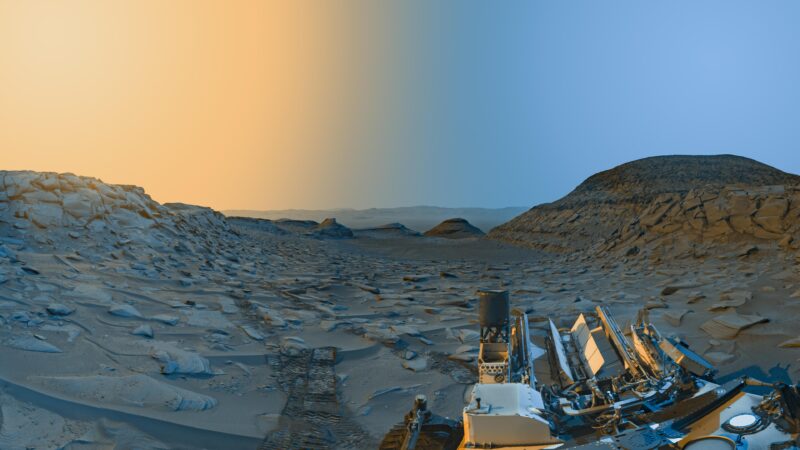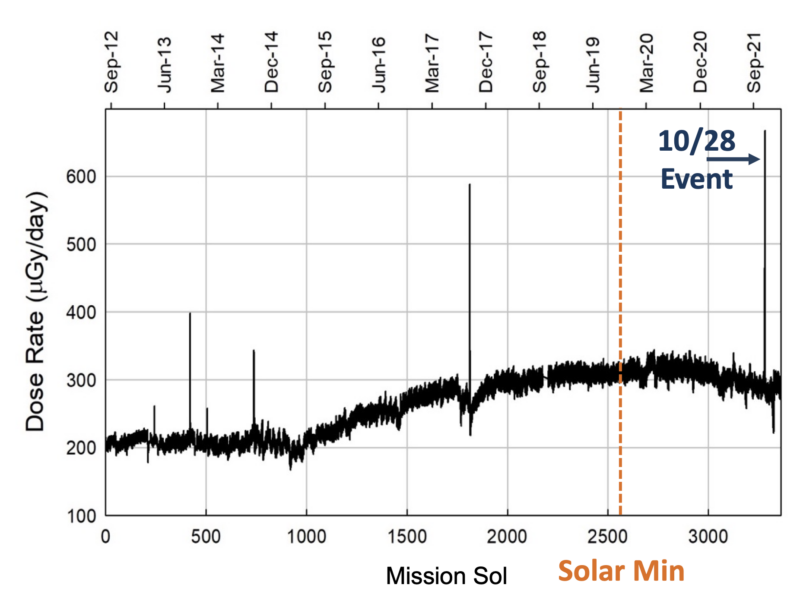
Eleven years ago today, NASA’s Curiosity rover landed gently on the surface of Mars. Promotional materials described the groundbreaking landing attempt as “Seven Minutes of Terror.” Curiosity’s fate hinged upon a heat shield larger than the base of the Apollo Command Module, the largest supersonic parachute ever developed, and a hovering rocket-powered descent stage which lowered the rover to the ground from a cable. An exhaustive series of tests and simulations indicated that each of these elements should work, but prior to August 6th, 2012, they had never been tested as an integrated system. NASA’s gamble payed off spectacularly. To date, Curiosity has traveled 18.9 miles from its landing site, captured over a million images, and discovered that Mars once possessed all of the geochemical ingredients required by life. For an 11-year-old rover, Curiosity is remarkably healthy, and she continues to return valuable data on how Mars lost its habitability.

Last year, shortly after she celebrated her tenth anniversary, Curiosity exited a natural thoroughfare dubbed Paraitepuy Pass. This route threaded between two large buttes, which provided impressive vistas for the rover’s cameras. However, the local scenery also posed challenges for the rover drivers who guide Curiosity through unexplored terrain. As she moved through the pass, Curiosity had to carefully tread over fine-grained ripples of dust and sharp rocks which can damage her wheels. On one occasion, she stopped less than a foot short of a large boulder. While these hazards certainly posed challenges, Paraitepuy Pass was the only adequate route uphill towards one of the mission’s marquee targets: the “Marker Band” valley.

Even before Curiosity landed on Mars, the Marker Band has been a tantalizing region of interest for the mission’s scientists. They originally dispatched the rover to Gale Crater because the site preserves a unique record of the Martian climate. Gale’s central peak, Mount Sharp, is a towering three-mile-tall mountain of sedimentary rock. According to the geological law of superposition, sediments are always deposited in age order, with younger rocks on top of older rocks. Curiosity’s mission is to explore up to two billion years of Martian history by climbing Mount Sharp, reading the sedimentary layers like a history book as she drives.
Curiosity previously explored the clay-rich rocks beneath the Marker Band, which were deposited in clement lakes with neutral pHs. Above the Marker Band, there is a thick layer of sulfate minerals, which are usually found in acidic, evaporating bodies of water. As it lies between these two types of rock, planetary scientists hypothesized that the Marker Band itself could represent an environmental calamity, such as the loss of Mars’ magnetic field. The Curiosity team expected to find evidence for an abrupt transition from a habitable ancient climate to the arid environment which we see today, which is one of the most important events in Mars’ history.

To unravel the mystery of the Marker Band, Curiosity spent the next nine months collecting data on the area with her suite of ten instruments. The local rocks were abnormally hard, but after several failed attempts, she collected three samples for analysis in her onboard chemistry lab. However, it was the Mastcam-Z cameras which made the most important discovery of the year. Their crisp photos revealed that the flat rocks within the Marker Band are covered in a ubiquitous rippled texture. As many beachgoers know, sand ripples are created by waves as they flow over a shallow body of water and sculpt the underlying sand and mud. Curiosity’s observations imply that similar waves once lapped gently across Gale Crater, 3.3 billion years ago. At this point in time, the water was probably salty and shallow, but it still could have persisted for hundreds, if not thousands, of years. “We climbed through thousands of feet of lake sediments and never saw evidence like this,” said Project Scientist Ashwin Vasavada. “Now, we found it in a place we expected to be dry.” [1]

Gale Crater might still preserve evidence of how Mars lost its habitability. If it exists, this information lies ahead in a thick zone of sulfate minerals. While Curiosity spent much of this year investigating the Marker Band, she took a brief detour in November to investigate Gediz Vallis Ridge, a pile of rubble which was deposited by what appears to be an ancient river channel. The rover was unable to scale the steep ridge, but she did use her ChemCam telescopic imager to collect detailed images of the feature. Once Curiosity finished investigating the Marker Band in May, they directed the rover towards the gaping channel of Gediz Vallis itself. The rover is currently en route to this location, which many scientists hope will reveal the final gasps of the lake in Gale Crater.

However, as of this writing, Curiosity has temporarily paused to investigate a different type of feature. The Jau crater cluster contains some of the only craters on Mount Sharp, since the unceasing erosion of the mountain’s flanks has erased most impact scars. “The team is hoping to assess the target rocks, any evidence for the impactor, and the morphology of the craters,” said USGS planetary scientist Lauren Edgar. [2] In particular, the rover team is hunting for meteorite fragments in the vicinity of the craters. The chemistry of the impactor could reveal whether it came from the asteroid belt, or whether it was ejected by a larger impact elsewhere on Mars. Thus far, the search for meteorites at the Jau cluster has been unsuccessful, but Curiosity did encounter a large, reflective meteorite made of nickel and iron in January.

Meanwhile, Curiosity’s Radiation Assessment Detector (RAD) continues to collect vital data for the future human exploration of Mars. Solar and cosmic radiation is one of the primary threats facing astronauts in deep space, and it has a substantial influence on the design of spacecraft. For instance, the Artemis program’s Orion capsule includes a radiation shelter to protect its crews from solar storms. The RAD instrument was designed to measure the radiation dosage which astronauts will experience during a Mars mission, both in space and on the planet’s surface. Thanks to Curiosity’s longevity, RAD has now been able to study an entire 11-year cycle of solar activity. This treasure trove of data will allow NASA to adequately protect the first human explorers of Mars, no matter when they launch. Additionally, the RAD instrument team recently noted that the influx of radiation decreased significantly during Mars’ 2018 global dust storm. This finding supports the conjecture that habitats on the Moon or Mars should be buried in regolith to protect astronauts from radiation.

Beyond her scientific accomplishments, Curiosity continues to capture our imaginations with her beautiful images. The rover is currently exploring what might be the most spectacular scenery visited on Mars to date. The foothills of Mount Sharp, which appeared to be miniscule from the distance of the landing site, now tower over the rover. These rounded buttes of finely-layered rock began appearing in the Greenheugh Pediment area, which Curiosity visited in 2021, and they are responsible for some of the most impressive photographs.
In addition, the Mastcam imaging team continues to contrive new methods for portraying the Martian scenery. The title image at the beginning of this article shows Curiosity’s view of dawn in Gale Crater. Curiosity, as well as its forbearers Sprit and Opportunity, has captured telescopic views of sunrise and sunset in the past. However, the rovers were never able to capture a panoramic view of the landscape during this “golden hour,” as the rapidly-changing hues in the sky could not be captured through the glacial pace of rover movements. Instead, the Mastcam team collected a black-and-white panorama over two separate photography sessions, and then manually added color to the scene to create this alien, yet also somewhat familiar, composition.

Other recent images from Curiosity have captured Mars’ ethereal clouds in stunning detail. Clouds are relatively scarce in Mars’ thin atmosphere, but they have been seen on occasion by NASA’s series of rovers. In January, Curiosity conducted a new imaging survey to search for clouds shortly after sunset. Noctilucent, or night-shining, clouds are sometimes visible on Earth in the hours after dusk. These eerie yet beautiful cloud formations float at a high altitude, where they can be illuminated by the Sun after it sets from the perspective of an observer on the ground. A similar phenomenon is responsible for the Curiosity image seen above. The cloud’s prismatic colors are caused by shifts in the size of microscopic aerosol particles within the cloud itself.

After 11 years, Curiosity is beginning to show signs of her age. The most infamous life-limiting items on the rover are her six wheels. The rocks in Gale Crater were more jagged than the rover’s designers had anticipated, and they have punctured each wheel on numerous occasions. To minimize the damage, the rover drivers have adapted their drive plans. They intentionally steer Curiosity around areas with high concentrations of sharp rocks. Some damage is unavoidable; one of the reinforced chevron-shaped grousers on a wheel snapped in 2017. Fortunately, the Curiosity team is confident that the wheels will remain intact through the end of her lifespan.

That lifespan is set by the rover’s Radioisotope Thermoelectric Generator, which produces a steady supply of energy and heat for her systems. The plutonium-238 within the generator decays exponentially. The energy output of any RTG-powered spacecraft will eventually decline to the point where it is unable to power its instruments. This process is already beginning to take hold for Curiosity. On June 26th, 2023, USGS planetary scientist Ken Herkenhoff remarked, “As in many recent MSL plans, power limited what we could fit into today’s 2-sol plan (…) we need to run our heaters a lot longer in the winter, and that means using a lot more power.” [3] Prior to Curiosity’s launch, NASA estimated that Curiosity would have enough plutonium to operate unhindered for 14 years. Curiosity will likely be able to operate beyond this point, but eventually, the team might need to shut off one or more science instruments and/or park the rover during the winter.

However, Curiosity remains healthy, with many years of life ahead of her. NASA intends to operate the rover for as long as her power supply lasts. During the coming year, she will slowly meander up Gediz Vallis, mapping Gale Crater’s sulfate deposits in the process. The team hopes to determine how the valley was carved and how Mars’ climate became increasingly arid. In the longer term, Curiosity may be able to reach a pile of volcanic ash which crows Mount Sharp. These ash layers are readily eroded by wind and sculpted into intricate yardangs. As Curiosity drives into her second decade, we celebrate the achievements of her team while looking forward to the exploration and the discoveries which lie ahead.





